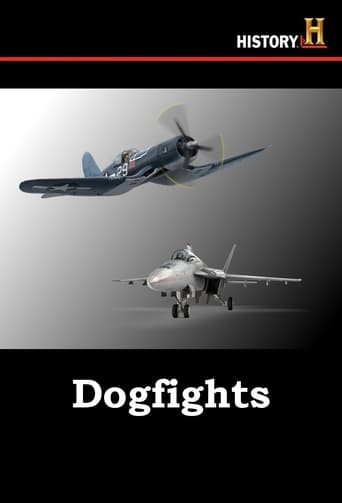SnoopyStyle
This is a History Channel program depicting various aerial battles. The time era takes place from the first generation bi-planes to modern aviators during Desert Storm. The Phil Crowley narrations give the program a steady newsreel sensibilities. There are military experts, historians, and sometimes, actual participants in those battles. It has old footage, maps, and most importantly CGI recreations of the aerial combat. The CGI is good for TV of that time period. It is excellent at presenting the combat tactics of these pilots. The show gives the general specifications of these planes and describe their strength and weaknesses. The CGI is able to inject action into the documentary programs. This is a must for aerial combat enthusiasts of any era.
grantss
Great documentary series.As the name suggests, a documentary series on aerial dogfights. Includes World War 1, World War 2, Korean War, Vietnam, 6 Day War, Yom Kippur and the two invasions of Iraq. Also has different forms of aerial combat, including naval and night-fighting.Good narration, great CGI and good, relevant stories. Often shows a progression in tactics within the one episode.About the only negative is that it is very US-centric. Most of the dogfights shown involve US pilots. No Red Baron (if I recall) and very little about the myriad of German Aces of WW2.
castott
There should be no doubt that this is a highly biased and jingoistic American program, though, to be fair, it is primarily aimed at an American audience, the concept of American military supremacy ("Americans have never and will never lose a war.") being a large part of the American identity--like it or not. Overall, I regard this series as more entertainment than a collection of historically correct documentaries. If you read official reports of the engagements portrayed in these animations you will, in many cases, discover that some significant details have been omitted or down-played for various reasons. For instance, in the second season episode with Lou Luma, the American RCAF Mosquito pilot, they fail to mention the somewhat important fact that in his portrayed strafing mission (I agree, not really dogfighting) to the German aerodrome, his tail was nearly shot off by anti-aircraft fire (http://www.acesofww2.com/Canada/aces/luma.htm).Americans are generally fond of emphasizing their role in various wars all the while down-playing or ignoring those of their allies, especially in cases where their allies'accomplishments were as good or better. Take for instance the clear anti-British and anti-Canadian (Canadians barely mentioned) bias shown by the celebrated, though increasingly discredited, American "historian" Stephen Ambrose particularly in his books concerning the D-Day landings. Also, consider the attitude that generated the American half-joke regarding the alternate meaning of the acronym of the American Expeditionary Force (AEF) in World War 1--"After England Fails". I believe the Australians also have some legitimate complaints regarding the overshadowing of their role early on in stopping the Japanese advances in New Guinea, and their overall achievements in the Pacific Theatre during WW2. Often, it seems that General MacArthur and the American media neglected to fully acknowledge the considerable efforts of the Australians under his command.I think it is inevitable that if this show is to continue they will have to begin focusing more on the aerial exploits of non-American allies and possibly even enemies. There has been absolutely nothing about the Russians in World War 2 (or in any conflict) which is largely inexcusable considering the prime importance of battles on the Eastern Front from mid 1941 to the end of the war (the Americans may not want to recognize the longer and possibly greater role of the Soviet forces in destroying the German Reich), and very little concerning British Empire and French dogfighters in either war which I also think is a shame. I doubt that further depictions of "dogfights" of the Korean, Vietnam and Gulf wars or Israeli-Arab conflicts will be of sufficiently broad appeal as these are more controversial in terms of the motives behind the conflicts(Americans/Israelis won't necessarily be seen as the good guys) and in most of these cases the battles don't involve true dogfighting skills. Also, I think that they have already covered a lot (most?) of the territory regarding significant American dogfights of WW1 and WW2. Any additional focus on the same will make their biases undeniable.The Americans were "Johnny come latelies" to both of the World Wars so, I don't know how much interest the producers of this show would have in aerial battles/campaigns before their entry, or in the early days following their entry into the wars, (e.g. in the Tunisian Campaign wherein they didn't do that well in the air or on the ground), but it is certainly something to hope for.I await the third season which I assume is now in production.
bard-32
Dogfights is about the famous dogfights of World I to today. The show is based on a two-hour special that aired in late 2005. The show has chronicled the dogfights from World War II, Korea, and Vietnam. The most recent one was called Death of the Bismarck. It was about the British pilots who'd sunk the German battleship Bismarck in May 1941. There were also episodes about MiG Alley and Operation Bolo. The best episode was about the F6F Hellcat and the Japanese Zero. Another one was about the Flying Tigers. In some episodes, the actual veterans themselves, talk about their experiences. The animation is like a video game. There was an episode about the F-8 Crusader which was the last gunfighter. The F-8 was involved in a dogfight that lasted ten minutes. The longest dogfight in Vietnam. Operation Bolo was a successful attempt to lure the elusive MiG-21a into combat. The show has all the elements of a video game and this show is great.
